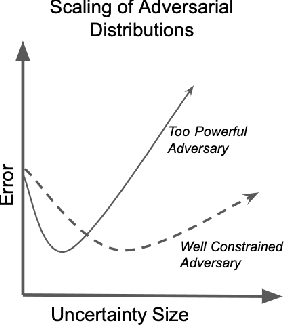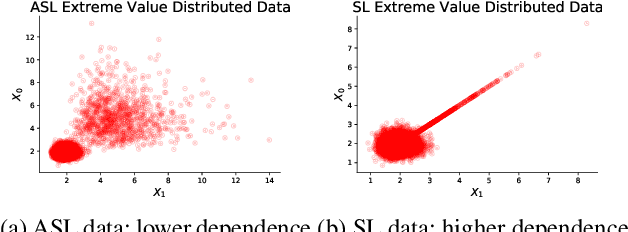Wenhao Yang
Discounted Online Convex Optimization: Uniform Regret Across a Continuous Interval
May 26, 2025Abstract:Reflecting the greater significance of recent history over the distant past in non-stationary environments, $\lambda$-discounted regret has been introduced in online convex optimization (OCO) to gracefully forget past data as new information arrives. When the discount factor $\lambda$ is given, online gradient descent with an appropriate step size achieves an $O(1/\sqrt{1-\lambda})$ discounted regret. However, the value of $\lambda$ is often not predetermined in real-world scenarios. This gives rise to a significant open question: is it possible to develop a discounted algorithm that adapts to an unknown discount factor. In this paper, we affirmatively answer this question by providing a novel analysis to demonstrate that smoothed OGD (SOGD) achieves a uniform $O(\sqrt{\log T/1-\lambda})$ discounted regret, holding for all values of $\lambda$ across a continuous interval simultaneously. The basic idea is to maintain multiple OGD instances to handle different discount factors, and aggregate their outputs sequentially by an online prediction algorithm named as Discounted-Normal-Predictor (DNP) (Kapralov and Panigrahy,2010). Our analysis reveals that DNP can combine the decisions of two experts, even when they operate on discounted regret with different discount factors.
Cream of the Crop: Harvesting Rich, Scalable and Transferable Multi-Modal Data for Instruction Fine-Tuning
Mar 17, 2025Abstract:The hypothesis that pretrained large language models (LLMs) necessitate only minimal supervision during the fine-tuning (SFT) stage (Zhou et al., 2024) has been substantiated by recent advancements in data curation and selection research. However, their stability and generalizability are compromised due to the vulnerability to experimental setups and validation protocols, falling short of surpassing random sampling (Diddee & Ippolito, 2024; Xia et al., 2024b). Built upon LLMs, multi-modal LLMs (MLLMs), combined with the sheer token volume and heightened heterogeneity of data sources, amplify both the significance and complexity of data selection. To harvest multi-modal instructional data in a robust and efficient manner, we re-define the granularity of the quality metric by decomposing it into 14 vision-language-related capabilities, and introduce multi-modal rich scorers to evaluate the capabilities of each data candidate. To promote diversity, in light of the inherent objective of the alignment stage, we take interaction style as diversity indicator and use a multi-modal rich styler to identify data instruction patterns. In doing so, our multi-modal rich scorers and styler (mmSSR) guarantee that high-scoring information is conveyed to users in diversified forms. Free from embedding-based clustering or greedy sampling, mmSSR efficiently scales to millions of data with varying budget constraints, supports customization for general or specific capability acquisition, and facilitates training-free generalization to new domains for curation. Across 10+ experimental settings, validated by 14 multi-modal benchmarks, we demonstrate consistent improvements over random sampling, baseline strategies and state-of-the-art selection methods, achieving 99.1% of full performance with only 30% of the 2.6M data.
Exploring the Adversarial Vulnerabilities of Vision-Language-Action Models in Robotics
Nov 22, 2024



Abstract:Recently in robotics, Vision-Language-Action (VLA) models have emerged as a transformative approach, enabling robots to execute complex tasks by integrating visual and linguistic inputs within an end-to-end learning framework. While VLA models offer significant capabilities, they also introduce new attack surfaces, making them vulnerable to adversarial attacks. With these vulnerabilities largely unexplored, this paper systematically quantifies the robustness of VLA-based robotic systems. Recognizing the unique demands of robotic execution, our attack objectives target the inherent spatial and functional characteristics of robotic systems. In particular, we introduce an untargeted position-aware attack objective that leverages spatial foundations to destabilize robotic actions, and a targeted attack objective that manipulates the robotic trajectory. Additionally, we design an adversarial patch generation approach that places a small, colorful patch within the camera's view, effectively executing the attack in both digital and physical environments. Our evaluation reveals a marked degradation in task success rates, with up to a 100\% reduction across a suite of simulated robotic tasks, highlighting critical security gaps in current VLA architectures. By unveiling these vulnerabilities and proposing actionable evaluation metrics, this work advances both the understanding and enhancement of safety for VLA-based robotic systems, underscoring the necessity for developing robust defense strategies prior to physical-world deployments.
Limit Theorems for Stochastic Gradient Descent with Infinite Variance
Oct 21, 2024Abstract:Stochastic gradient descent is a classic algorithm that has gained great popularity especially in the last decades as the most common approach for training models in machine learning. While the algorithm has been well-studied when stochastic gradients are assumed to have a finite variance, there is significantly less research addressing its theoretical properties in the case of infinite variance gradients. In this paper, we establish the asymptotic behavior of stochastic gradient descent in the context of infinite variance stochastic gradients, assuming that the stochastic gradient is regular varying with index $\alpha\in(1,2)$. The closest result in this context was established in 1969 , in the one-dimensional case and assuming that stochastic gradients belong to a more restrictive class of distributions. We extend it to the multidimensional case, covering a broader class of infinite variance distributions. As we show, the asymptotic distribution of the stochastic gradient descent algorithm can be characterized as the stationary distribution of a suitably defined Ornstein-Uhlenbeck process driven by an appropriate stable L\'evy process. Additionally, we explore the applications of these results in linear regression and logistic regression models.
Neuron-based Personality Trait Induction in Large Language Models
Oct 16, 2024Abstract:Large language models (LLMs) have become increasingly proficient at simulating various personality traits, an important capability for supporting related applications (e.g., role-playing). To further improve this capacity, in this paper, we present a neuron-based approach for personality trait induction in LLMs, with three major technical contributions. First, we construct PersonalityBench, a large-scale dataset for identifying and evaluating personality traits in LLMs. This dataset is grounded in the Big Five personality traits from psychology and is designed to assess the generative capabilities of LLMs towards specific personality traits. Second, by leveraging PersonalityBench, we propose an efficient method for identifying personality-related neurons within LLMs by examining the opposite aspects of a given trait. Third, we develop a simple yet effective induction method that manipulates the values of these identified personality-related neurons. This method enables fine-grained control over the traits exhibited by LLMs without training and modifying model parameters. Extensive experiments validate the efficacy of our neuron identification and trait induction methods. Notably, our approach achieves comparable performance as fine-tuned models, offering a more efficient and flexible solution for personality trait induction in LLMs. We provide access to all the mentioned resources at https://github.com/RUCAIBox/NPTI.
You Only Speak Once to See
Sep 27, 2024



Abstract:Grounding objects in images using visual cues is a well-established approach in computer vision, yet the potential of audio as a modality for object recognition and grounding remains underexplored. We introduce YOSS, "You Only Speak Once to See," to leverage audio for grounding objects in visual scenes, termed Audio Grounding. By integrating pre-trained audio models with visual models using contrastive learning and multi-modal alignment, our approach captures speech commands or descriptions and maps them directly to corresponding objects within images. Experimental results indicate that audio guidance can be effectively applied to object grounding, suggesting that incorporating audio guidance may enhance the precision and robustness of current object grounding methods and improve the performance of robotic systems and computer vision applications. This finding opens new possibilities for advanced object recognition, scene understanding, and the development of more intuitive and capable robotic systems.
Channel Adaptation for Speaker Verification Using Optimal Transport with Pseudo Label
Sep 14, 2024



Abstract:Domain gap often degrades the performance of speaker verification (SV) systems when the statistical distributions of training data and real-world test speech are mismatched. Channel variation, a primary factor causing this gap, is less addressed than other issues (e.g., noise). Although various domain adaptation algorithms could be applied to handle this domain gap problem, most algorithms could not take the complex distribution structure in domain alignment with discriminative learning. In this paper, we propose a novel unsupervised domain adaptation method, i.e., Joint Partial Optimal Transport with Pseudo Label (JPOT-PL), to alleviate the channel mismatch problem. Leveraging the geometric-aware distance metric of optimal transport in distribution alignment, we further design a pseudo label-based discriminative learning where the pseudo label can be regarded as a new type of soft speaker label derived from the optimal coupling. With the JPOT-PL, we carry out experiments on the SV channel adaptation task with VoxCeleb as the basis corpus. Experiments show our method reduces EER by over 10% compared with several state-of-the-art channel adaptation algorithms.
Integrated Multi-Level Knowledge Distillation for Enhanced Speaker Verification
Sep 14, 2024



Abstract:Knowledge distillation (KD) is widely used in audio tasks, such as speaker verification (SV), by transferring knowledge from a well-trained large model (the teacher) to a smaller, more compact model (the student) for efficiency and portability. Existing KD methods for SV often mirror those used in image processing, focusing on approximating predicted probabilities and hidden representations. However, these methods fail to account for the multi-level temporal properties of speech audio. In this paper, we propose a novel KD method, i.e., Integrated Multi-level Knowledge Distillation (IML-KD), to transfer knowledge of various temporal-scale features of speech from a teacher model to a student model. In the IML-KD, temporal context information from the teacher model is integrated into novel Integrated Gradient-based input-sensitive representations from speech segments with various durations, and the student model is trained to infer these representations with multi-level alignment for the output. We conduct SV experiments on the VoxCeleb1 dataset to evaluate the proposed method. Experimental results demonstrate that IML-KD significantly enhances KD performance, reducing the Equal Error Rate (EER) by 5%.
Distributionally Robust Optimization as a Scalable Framework to Characterize Extreme Value Distributions
Jul 31, 2024



Abstract:The goal of this paper is to develop distributionally robust optimization (DRO) estimators, specifically for multidimensional Extreme Value Theory (EVT) statistics. EVT supports using semi-parametric models called max-stable distributions built from spatial Poisson point processes. While powerful, these models are only asymptotically valid for large samples. However, since extreme data is by definition scarce, the potential for model misspecification error is inherent to these applications, thus DRO estimators are natural. In order to mitigate over-conservative estimates while enhancing out-of-sample performance, we study DRO estimators informed by semi-parametric max-stable constraints in the space of point processes. We study both tractable convex formulations for some problems of interest (e.g. CVaR) and more general neural network based estimators. Both approaches are validated using synthetically generated data, recovering prescribed characteristics, and verifying the efficacy of the proposed techniques. Additionally, the proposed method is applied to a real data set of financial returns for comparison to a previous analysis. We established the proposed model as a novel formulation in the multivariate EVT domain, and innovative with respect to performance when compared to relevant alternate proposals.
Robust Channel Learning for Large-Scale Radio Speaker Verification
Jun 16, 2024Abstract:Recent research in speaker verification has increasingly focused on achieving robust and reliable recognition under challenging channel conditions and noisy environments. Identifying speakers in radio communications is particularly difficult due to inherent limitations such as constrained bandwidth and pervasive noise interference. To address this issue, we present a Channel Robust Speaker Learning (CRSL) framework that enhances the robustness of the current speaker verification pipeline, considering data source, data augmentation, and the efficiency of model transfer processes. Our framework introduces an augmentation module that mitigates bandwidth variations in radio speech datasets by manipulating the bandwidth of training inputs. It also addresses unknown noise by introducing noise within the manifold space. Additionally, we propose an efficient fine-tuning method that reduces the need for extensive additional training time and large amounts of data. Moreover, we develop a toolkit for assembling a large-scale radio speech corpus and establish a benchmark specifically tailored for radio scenario speaker verification studies. Experimental results demonstrate that our proposed methodology effectively enhances performance and mitigates degradation caused by radio transmission in speaker verification tasks. The code will be available on Github.
 Add to Chrome
Add to Chrome Add to Firefox
Add to Firefox Add to Edge
Add to Edge